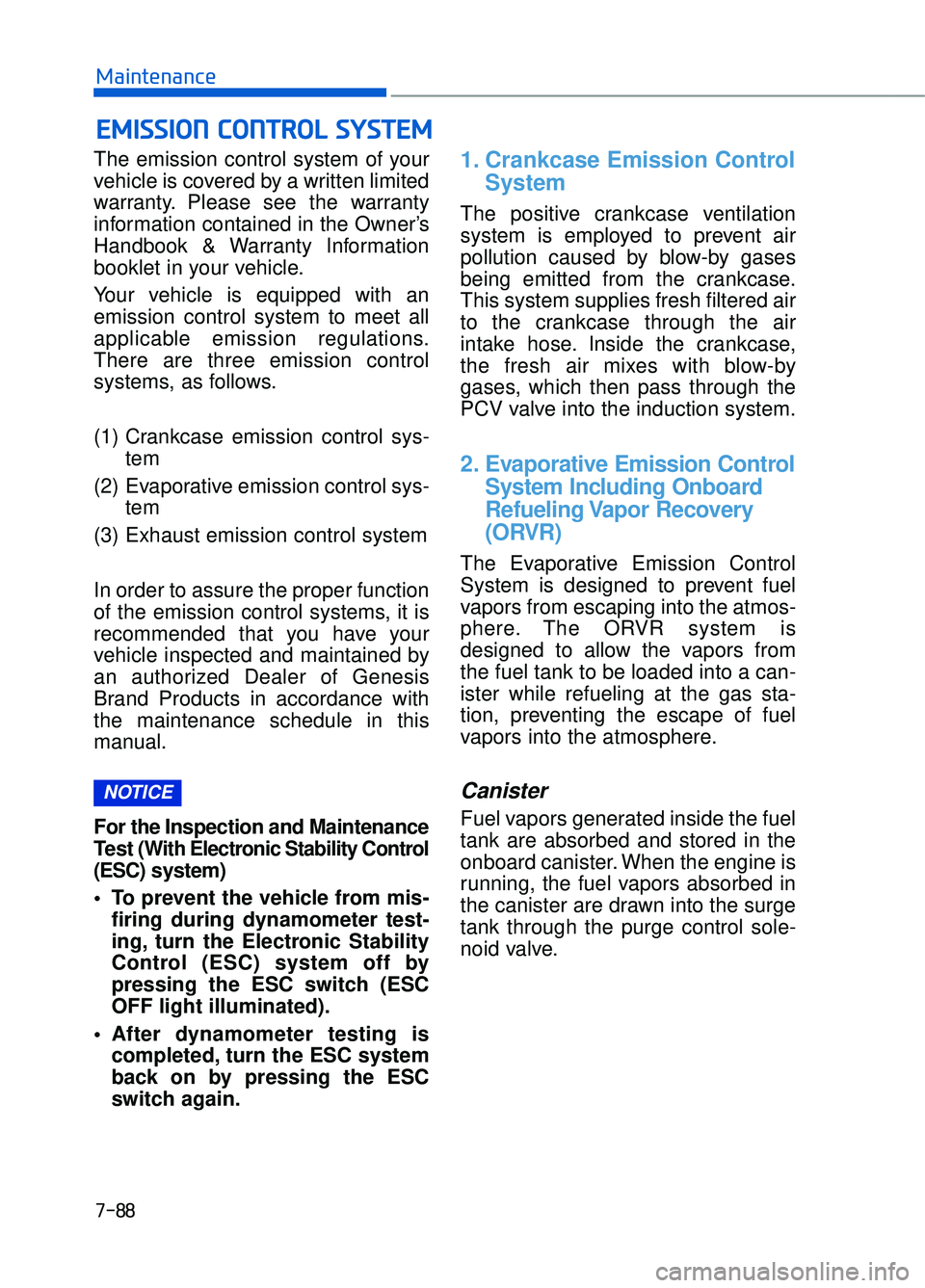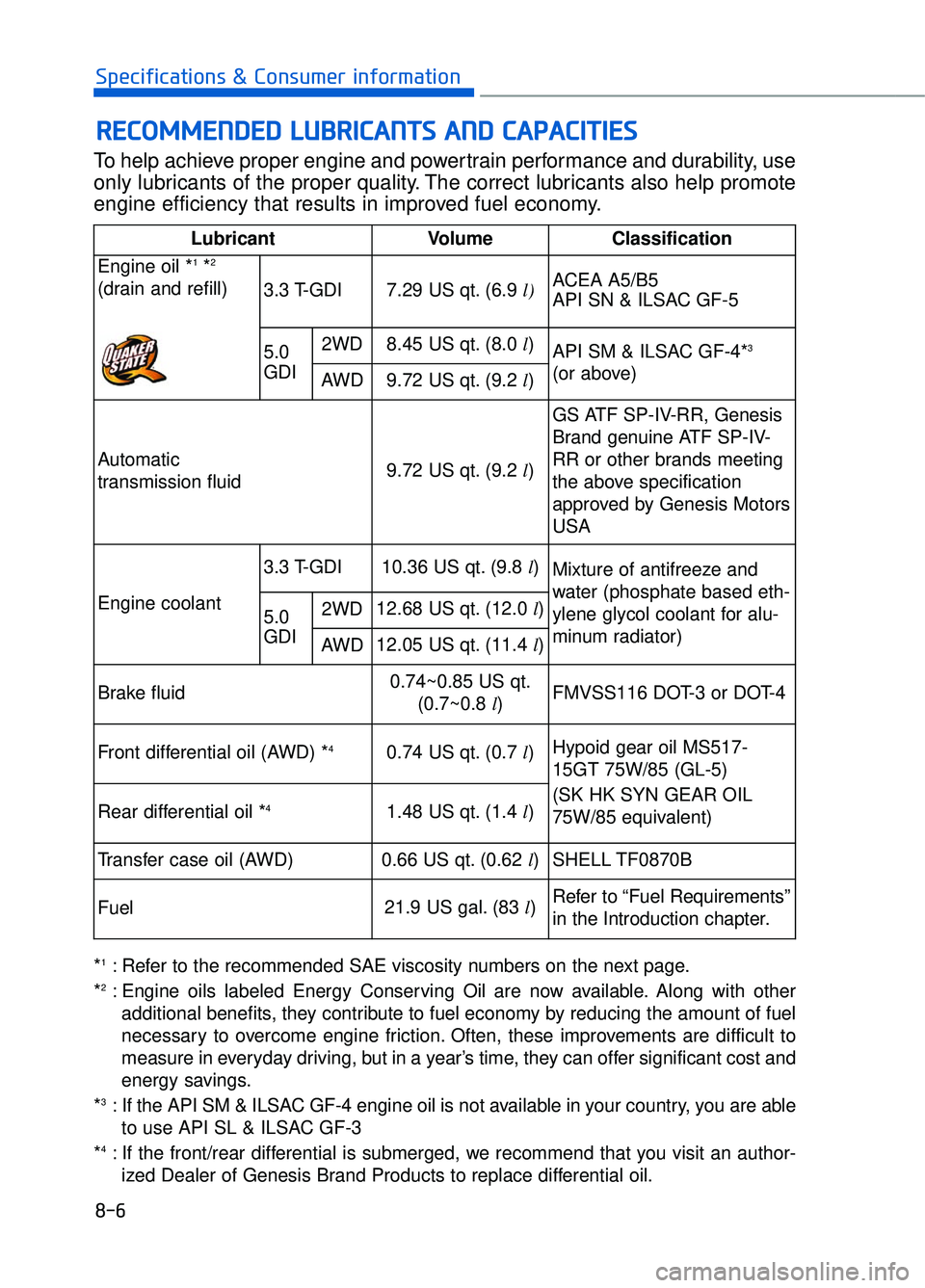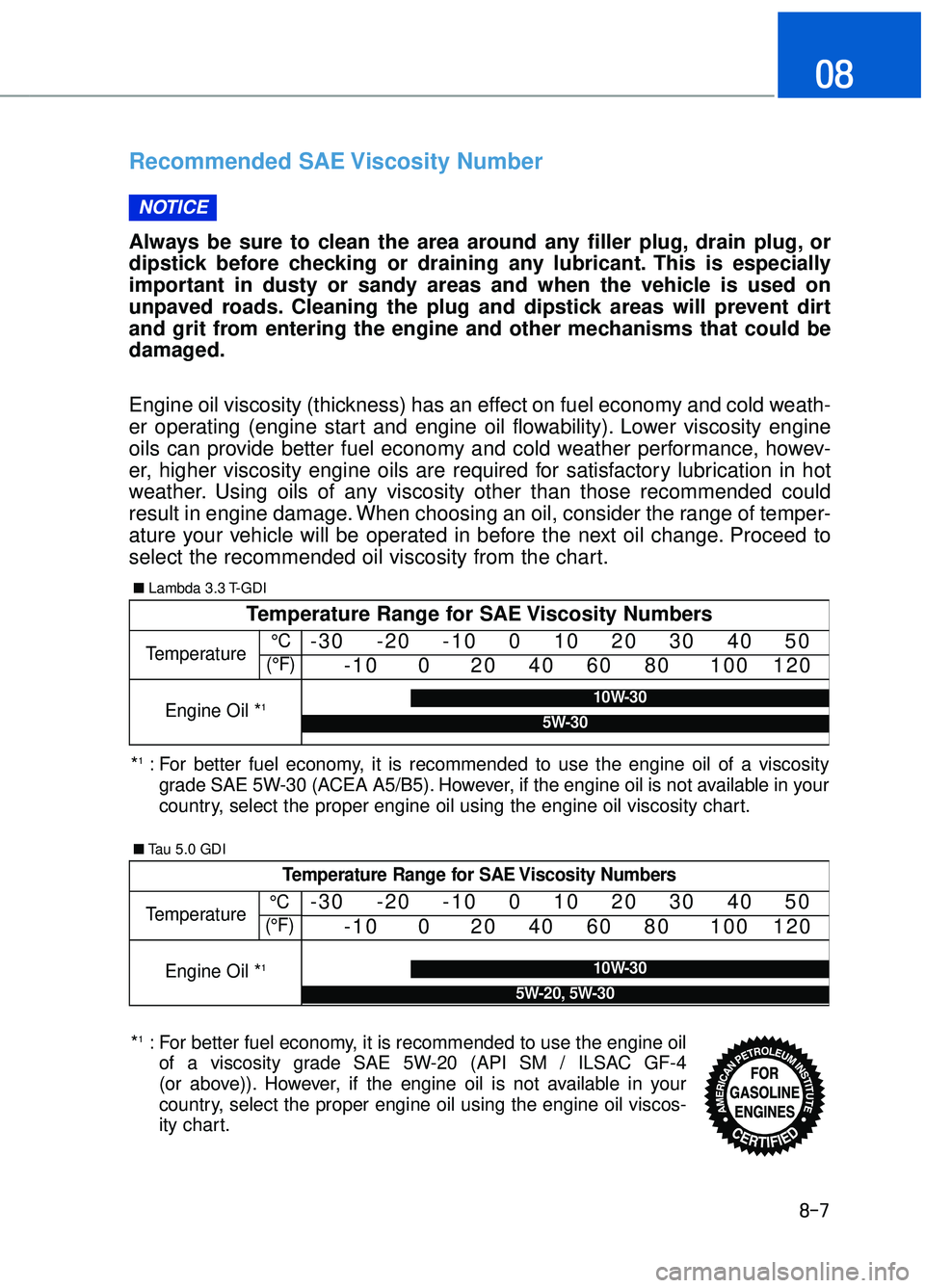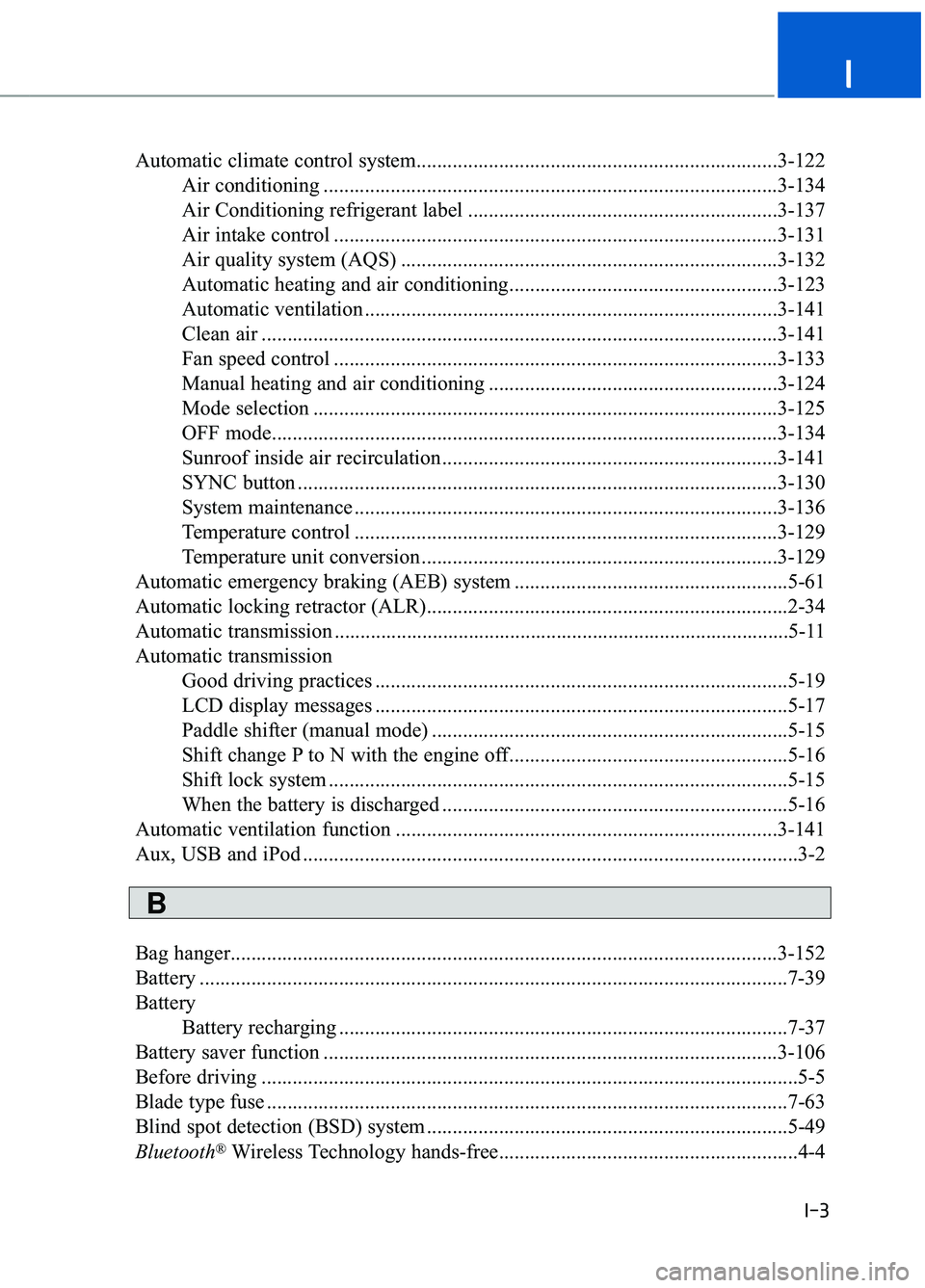engine GENESIS G90 2017 Owner's Manual
[x] Cancel search | Manufacturer: GENESIS, Model Year: 2017, Model line: G90, Model: GENESIS G90 2017Pages: 524, PDF Size: 19.3 MB
Page 484 of 524

7-82
Maintenance
Do not use strong soap, chemi- cal detergents or hot water, and
do not wash the vehicle in direct
sunlight or when the body of the
vehicle is warm.
Be careful when washing the side windows of your vehicle.
Especially, with high-pressure
water, water may leak through
the windows and wet the interior.
To prevent damage to the plastic parts, do not clean with chemi-
cal solvents or strong deter-
gents.
Water washing in the engine compartment including high
pressure water washing may
cause the failure of electrical cir-
cuits located in the engine com-
partment.
Never allow water or other liq- uids to come in contact with
electrical/electronic compo-
nents inside the vehicle as this
may damage them.
Waxing
A good coat of wax provides a barri-
er between your paint and environ-
mental contamination.
Keeping a good coat of wax on your
vehicle will help protect it.
Wax the vehicle when water will no
longer bead on the paint.
Always wash and dry the vehicle
before waxing. Use a good quality
liquid or paste wax, and follow the
manufacturer’s instructions. Wax all
metal trim to protect it and to main-
tain its luster.
Removing oil, tar, and similar materi-
als with a spot remover will usually
strip the wax from the finish. Be sure
to re-wax these areas even if the rest
of the vehicle does not yet need wax-
ing.
Wiping dust or dirt off the bodywith a dry cloth will scratch the
finish.
Do not use steel wool, abrasive cleaners, or strong detergents
containing highly alkaline or
caustic agents on chrome-plat-
ed or anodized aluminum parts.
This may result in damage to the
protective coating and cause
discoloration or paint deteriora-
tion.
NOTICE
NOTICE
NOTICE
OHI076049N
Page 490 of 524

7-88
Maintenance
The emission control system of your
vehicle is covered by a written limited
warranty. Please see the warranty
information contained in the Owner’s
Handbook & Warranty Information
booklet in your vehicle.
Your vehicle is equipped with an
emission control system to meet all
applicable emission regulations.
There are three emission control
systems, as follows.
(1) Crankcase emission control sys- tem
(2) Evaporative emission control sys- tem
(3) Exhaust emission control system
In order to assure the proper function
of the emission control systems, it is
recommended that you have your
vehicle inspected and maintained by
an authorized Dealer of Genesis
Brand Products in accordance with
the maintenance schedule in this
manual.
For the Inspection and Maintenance
Test (
With Electronic Stability Control
(ESC)
system)
To prevent the vehicle from mis- firing during dynamometer test-
ing, turn the Electronic Stability
Control (ESC) system off by
pressing the ESC switch (ESC
OFF light illuminated).
After dynamometer testing is completed, turn the ESC system
back on by pressing the ESC
switch again.
1. Crankcase Emission Control System
The positive crankcase ventilation
system is employed to prevent air
pollution caused by blow-by gases
being emitted from the crankcase.
This system supplies fresh filtered air
to the crankcase through the air
intake hose. Inside the crankcase,
the fresh air mixes with blow-by
gases, which then pass through the
PCV valve into the induction system.
2. Evaporative Emission ControlSystem Including Onboard
Refueling Vapor Recovery
(ORVR)
The Evaporative Emission Control
System is designed to prevent fuel
vapors from escaping into the atmos-
phere. The ORVR system is
designed to allow the vapors from
the fuel tank to be loaded into a can-
ister while refueling at the gas sta-
tion, preventing the escape of fuel
vapors into the atmosphere.
Canister
Fuel vapors generated inside the fuel
tank are absorbed and stored in the
onboard canister. When the engine is
running, the fuel vapors absorbed in
the canister are drawn into the surge
tank through the purge control sole-
noid valve.
NOTICE
E EM
M I
IS
S S
SI
IO
O N
N
C
C O
O N
NT
TR
R O
O L
L
S
S Y
Y S
ST
T E
EM
M
Page 491 of 524

7-89
07
Purge Control Solenoid Valve(PCSV)
The purge control solenoid valve is
controlled by the Engine Control
Module (ECM); when the engine
coolant temperature is low during
idling, the PCSV closes so that evap-
orated fuel is not taken into the
engine. After the engine warms-up
during ordinary driving, the PCSV
opens to introduce evaporated fuel to
the engine.
3. Exhaust Emission Control System
The Exhaust Emission Control
System is a highly effective system
which controls exhaust emissions
while maintaining good vehicle per-
formance.
When the engine starts or fails to
start, excessive attempts to restart
the engine may cause damage to the
emission system.
Engine exhaust (carbon monox-
ide) precautions
Carbon monoxide can be present
with other exhaust fumes. If you
smell exhaust fumes of any kind in
your vehicle, drive with all the win-
dows fully open. Have your vehicle
checked and repaired immediately. Do not operate the engine in con-
fined or closed areas (such as
garages) any more than what is
necessary to move the vehicle in or
out of the area.
When the vehicle is stopped in an open area for more than a short
time with the engine running,
adjust the ventilation system (as
needed) to draw outside air into the
vehicle.
Never sit in a parked or stopped vehicle for any extended time with
the engine running.
When the engine stalls or fails to start, excessive attempts to restart
the engine may cause damage to
the emission control system.
Engine exhaust gases contain
carbon monoxide (CO). Though
colorless and odorless, it is
dangerous and could be lethal if
inhaled. Follow the instructions
on this page to avoid CO poi-
soning.
WARNING
CALIFORNIA PROPOSITION 65
WARNING
Engine exhaust and a wide vari-
ety of automobile components
and parts, including compo-
nents found in the interior fur-
nishings in a vehicle, contain or
emit chemicals known to the
State of California to cause can-
cer and birth defects and repro-
ductive harm. In addition, cer-
tain fluids contained in vehicles
and certain products of compo-
nent wear contain or emit chem-
icals known to the State of
California to cause cancer and
birth defects or other reproduc-
tive harm.
WARNING
Page 492 of 524

7-90
Maintenance
Operating precautions for cat-alytic converters (if equipped)
Your vehicle is equipped with a cat-
alytic converter emission control
device.
To prevent damage to the catalytic
converter and to your vehicle, take
the following precautions: Use only UNLEADED FUEL for
gasoline engines.
Do not operate the vehicle when there are signs of engine mal-
function, such as misfire or a
noticeable loss of performance.
Do not misuse or abuse the engine. Examples of misuse are
coasting with the engine off and
descending steep grades in gear
with the engine off.
Do not operate the engine at high idle speed for extended
periods (5 minutes or more).
Do not modify or tamper with any part of the engine or emis-
sion control system. All inspec-
tions and adjustments must be
made by an authorized Dealer of
Genesis Brand Products.
Avoid driving with extremely low fuel level. If you run out of gaso-
line, it could cause the engine to
misfire and result in excessive
loading of the catalytic converter.
NOTICE
The exhaust system and cat-
alytic converter are very hot
during and immediately after
the engine has been running. To
avoid SERIOUS INJURY or
DEATH:
Do not park, idle, or drive thevehicle over or near flamma-
ble objects, such as grass,
vegetation, paper, leaves, etc.
A hot exhaust system can
ignite flammable items under
your vehicle.
Keep away from the exhaust system and catalytic convert-
er or you may get burned.
Also, Do not remove the heat
sink around the exhaust sys-
tem, do not seal the bottom of
the vehicle, and do not coat
the vehicle for corrosion con-
trol. It may present a fire risk
under certain conditions.
WARNING
Page 494 of 524

Dimensions ........................................................................\
............8-2
Engine ........................................................................\
....................8-2
Bulb Wattage ........................................................................\
........8-3
Tires and Wheels........................................................................\
..8-4
Luggage Volume ........................................................................\
...8-5
Gross Vehicle Weight...................................................................8-5
Air Conditioning System..............................................................8-5
Recommended Lubricants and Capacities ................................8-6
Recommended SAE Viscosity Number....................................................8-7
Vehicle Certification Label..........................................................8-8
Vehicle Identification Number (VIN) .........................................8-8
Tire Specification and Pressure Label......................................8-8
Refrigerant Label ........................................................................\
.8-9
Engine Number ........................................................................\
.....8-9
Consumer Information ...............................................................8-10
Reporting Safety Defects .........................................................8-11
8
S Sp
pe
ec
ci
if
f i
ic
c a
a t
ti
io
o n
ns
s
&
&
C
C o
on
ns
su
u m
m e
er
r
i
in
n f
fo
o r
rm
m a
at
ti
io
o n
n
Page 499 of 524

To help achieve proper engine and powertrain performance and durability, use
only lubricants of the proper quality. The correct lubricants also help promote
engine efficiency that results in improved fuel economy.
R RE
EC
CO
O M
M M
ME
EN
N D
DE
ED
D
L
L U
U B
BR
RI
IC
C A
A N
N T
TS
S
A
A N
N D
D
C
C A
A P
PA
A C
CI
IT
T I
IE
E S
S
8-6
Specifications & Consumer information
Lubricant VolumeClassification
Engine oil *
1*2
(drain and refill) 3.3 T-GDI7.29 US qt. (6.9
l)ACEA A5/B5
API SN & ILSAC GF-5
5.0
GDI2WD8.45 US qt. (8.0
l)API SM & ILSAC GF-4*3
(or above)AWD9.72 US qt. (9.2
l)
Automatic
transmission fluid 9.72 US qt. (9.2
l)GS ATF SP-IV-RR, Genesis
Brand genuine ATF SP-IV-
RR or other brands meeting
the above specification
approved by Genesis Motors
USA
Engine coolant 3.3 T-GDI
10.36 US qt. (9.8
l)
Mixture of antifreeze and
water (phosphate based eth-
ylene glycol coolant for alu-
minum radiator)
5.0
GDI2WD12.68 US qt. (12.0 l)
AWD12.05 US qt. (11.4l)
Brake fluid 0.74~0.85 US qt.
(0.7~0.8 l)FMVSS116 DOT-3 or DOT-4
Front differential oil (AWD) *
40.74 US qt. (0.7 l)Hypoid gear oil MS517-
15GT 75W/85 (GL-5)
(SK HK SYN GEAR OIL
75W/85 equivalent)
Rear differential oil *
41.48 US qt. (1.4
l)
Transfer case oil (AWD)0.66 US qt. (0.62 l)SHELL TF0870B
Fuel21.9 US gal. (83 l)Refer to “Fuel Requirements”
in the Introduction chapter.
*1: Refer to the recommended SAE viscosity numbers on the next page.
*2: Engine oils labeled Energy Conserving Oil are now available. Along with other additional benefits, they contribute to fuel economy by reducing the amount of fuel
necessary to overcome engine friction. Often, these improvements are difficult to
measure in everyday driving, but in a year’s time, they can offer significant cost and
energy savings.
*
3: If the API SM & ILSAC GF-4 engine oil is not available in your country, you are able to use API SL & ILSAC GF-3
*
4: If the front/rear differential is submerged, we recommend that you visit an author- ized Dealer of Genesis Brand Products to replace differential oil.
Page 500 of 524

8-7
08
Recommended SAE Viscosity Number
Always be sure to clean the area around any filler plug, drain plug, or
dipstick before checking or draining any lubricant. This is especially
important in dusty or sandy areas and when the vehicle is used on
unpaved roads. Cleaning the plug and dipstick areas will prevent dirt
and grit from entering the engine and other mechanisms that could be
damaged.
Engine oil viscosity (thickness) has an effect on fuel economy and cold weath-
er operating (engine start and engine oil flowability). Lower viscosity engine
oils can provide better fuel economy and cold weather performance, howev-
er, higher viscosity engine oils are required for satisfactory lubrication in hot
weather. Using oils of any viscosity other than those recommended could
result in engine damage. When choosing an oil, consider the range of temper-
ature your vehicle will be operated in before the next oil change. Proceed to
select the recommended oil viscosity from the chart.
NOTICE
*1: For better fuel economy, it is recommended to use the engine oilof a viscosity grade SAE 5W-20 (API SM / ILSAC GF-4
(or above)). However, if the engine oil is not available in your
country, select the proper engine oil using the engine oil viscos-
ity chart.
Temperature Range for SAE Viscosity Numbers
Temperature -30 -20 -10 0 10 20 30 40 50
-10 0 20 40 60 80 100 120
Engine Oil *110W-30
5W-30
°C
(°F)
Temperature Range for SAE Viscosity Numbers
Temperature -30 -20 -10 0 10 20 30 40 50
-10 0 20 40 60 80 100 120
Engine Oil *110W-30
5W-20, 5W-30
°C
(°F)
■ Lambda 3.3 T-GDI
■ Tau 5.0 GDI
*1: For better fuel economy, it is recommended to use the engine oil of a viscosity
grade SAE 5W-30 (ACEA A5/B5). However, if the engine oil is not available in your
country, select the proper engine oil using the engine oil viscosity chart.
Page 502 of 524

8-9
08
E
EN
N G
GI
IN
N E
E
N
N U
U M
M B
BE
ER
R
The engine number is stamped on
the engine block as shown in the
drawing. The refrigerant label provides infor-
mation such as refrigerant type and
amount.
The label is located on the underside
of the hood.
R R
E
EF
FR
R I
IG
G E
ER
R A
A N
N T
T
L
L A
A B
BE
EL
L
(
( I
IF
F
E
E Q
Q U
UI
IP
P P
PE
ED
D )
)
OHI086003
■Lambda 3.3 T-GDI
OHI086004
■ Tau 5.0 GDIOHI086008N
Page 507 of 524

Automatic climate control system......................................................................3-\
122Air conditioning ........................................................................\
................3-134
Air Conditioning refrigerant label ............................................................3-137
Air intake control ........................................................................\
..............3-131
Air quality system (AQS) ........................................................................\
.3-132
Automatic heating and air conditioning....................................................3-123
Automatic ventilation ........................................................................\
........3-141
Clean air ........................................................................\
............................3-141
Fan speed control ........................................................................\
..............3-133
Manual heating and air conditioning ........................................................3-124
Mode selection ........................................................................\
..................3-125
OFF mode........................................................................\
..........................3-134
Sunroof inside air recirculation .................................................................3-141
SYNC button ........................................................................\
.....................3-130
System maintenance ........................................................................\
..........3-136
Temperature control ........................................................................\
..........3-129
Temperature unit conversion .....................................................................3-1\
29
Automatic emergency braking (AEB) system .....................................................5-61
Automatic locking retractor (ALR)......................................................................2-\
34
Automatic transmission ........................................................................\
................5-11
Automatic transmission Good driving practices ........................................................................\
........5-19
LCD display messages ........................................................................\
........5-17
Paddle shifter (manual mode) .....................................................................5-1\
5
Shift change P to N with the engine off......................................................5-16
Shift lock system ........................................................................\
.................5-15
When the battery is discharged ...................................................................5-16
Automatic ventilation function ........................................................................\
..3-141
Aux, USB and iPod ........................................................................\
........................3-2
Bag hanger........................................................................\
..................................3-152
Battery ........................................................................\
..........................................7-39
Battery Battery recharging ........................................................................\
...............7-37
Battery saver function ........................................................................\
................3-106
Before driving ........................................................................\
................................5-5
Blade type fuse ........................................................................\
.............................7-63
Blind spot detection (BSD) system ......................................................................5-\
49
Bluetooth
®Wireless Technology hands-free..........................................................4-4
I-3
I
B
Page 508 of 524

Bottle holder ........................................................................\
...............................3-147
Brake fluid ........................................................................\
....................................7-33
Brake system ........................................................................\
................................5-25Anti-lock brake system (ABS) ....................................................................5-35\
Auto hold........................................................................\
.............................5-31
Disc brakes wear indicator ........................................................................\
..5-26
Electronic parking brake (EPB) ..................................................................5-26
Electronic stability control (ESC) ...............................................................5-37
Good braking practices ........................................................................\
.......5-42
Hill-start assist control (HAC) ....................................................................5-41\
Power brakes ........................................................................\
.......................5-25
Vehicle stability management (VSM) .........................................................5-40
Bulb replacement Daytime running light ........................................................................\
.........7-77
Front turn signal lamp ........................................................................\
.........7-77
Headlamp ........................................................................\
............................7-77
High mounted stop lamp ........................................................................\
.....7-79
Interior light bulb ........................................................................\
................7-80
License plate light bulb ........................................................................\
.......7-79
Rear combination light bulb........................................................................\
7-79
Side marker ........................................................................\
.........................7-77
Side repeater lamp ........................................................................\
..............7-79
Bulb wattage........................................................................\
...................................8-3
Button start/stop, see engine start/stop button .......................................................5-7
California perchlorate notice ........................................................................\
........7-91
Camera (Rear view) ........................................................................\
...................3-115
Capacities (Lubricants) ........................................................................\
..................3-6
Care Exterior care ........................................................................\
........................7-81 Interior care ........................................................................\
.........................7-86
Tire care........................................................................\
...............................7-43
Cartridge type fuse ........................................................................\
.......................7-63
Cellular phone holder ........................................................................\
.................3-145
Center console storage ........................................................................\
...............3-143
Central door lock switch ........................................................................\
..............3-11
Certification label ........................................................................\
...........................8-8
Chains Tire chains ........................................................................\
.........................5-106
I-4
Index
C